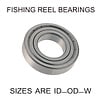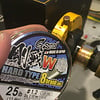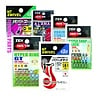Japanese jigging, butterfly jigging and mechanical jigging are terms used to describe a contemporary technique for fishing with long metal jigs, in a rhythmic action. The action goes something like this: drop the rod tip and wind the reel one revolution, lift the rod tip and repeat at speed, through the fish active water column. Sounds awkward but with practice it becomes a natural fluid action. Mechanical jigging is very effective, often out-fishing traditional speed jigging, mainly because the lure is kept longer in the fish zone and a more frenzied lure action produces more bites.
Jigging rods used are short, non-traditional parabolic high modulus graphite rods, which are very strong with huge lifting power and the parabolic action imparts some fluidity to the jig. These rods are generally not parabolic in the original sense but, with great hoop strength and thick walls, they are capable of handling heavy braid and massive drag pressures. Know this: not all rods are created equal. There are some real back-breaking shockers out there.Most good rods are factory-tested so if you break one, warranty claims may on deaf ears because it may have been used outside the manufacturer’s specifications.Rods are given a PE rating, which is the braid-breaking strain: PE-8 is 80lb, PE-5 is 50lb generally. Rods also have a rating for recommended lure weight, maximum reel drag setting and maximum angle at which the highest drag setting can be applied to not point-load the rod. Some popular rods are Smiths, Shimano jigwrex, Shimano blue rose, Xzoga, JM Jigging master, Terminator, Daiwa Monster Mesh and Power jig jig rods.
The reel specs are as follows: braid capable, ideally narrow, low speed between 4 and 5:1 for heavy braid PE 5 -8 (that’s 50 to 80lb, but usually breaks at 100 to 150lb crazy ratings but that’s the world of braid) and up to 6:1 ratio for lighter braid is fine. Popular reel brands include Daiwa Saltist, Daiwa Saltiga, Shimano Ocean Jigger, Shimano Torsa, Shimano Trinidad, Accurate Reel, and Ducro . There are also some exotics like Blue Heaven and everol . Factory drags are often up-rated with carbontex kits but be warned: this can void a warranty. However, you will find that these reels can take it when market handles (like the Power jig T-bar and Accurate round knobs) are fitted, making it more comfortable and less abrasive than a rubber handle. Spin or overhead? In New Zealand, we’re about 80/20 in favour of overhead. New Daiwa Saltiga 6500, Shimano Stella 2015SW 20000, 10000, 8000, 14000, 5000, 4000, are the pick of the bunch and will handle PE 5-8 braid and all low speed so you can get a crank on decent fish. Metal jigs, long jigs, knife jigs, 7 gram to 700 gram , centre, tail- and head-weighted, all shapes and sizes there is a huge variety of jigs, from designer to cheap. But you do get what you pay for. Good jigs don’t bend so much, the paint and prism film doesn’t lift and the wire that sticks out the end goes right through the jig. A kevlar cord, via a solid ring that is, in turn, attached to the jig by a strong split ring, usually connects the hook. Hooks need to be super-sharp and strong to ensure good penetration and holding power. Reliable brands include Zest Jigs, Power jig, Hayabusa, Hook Choice, Fisherman, Owner Monster and Mustad Hoodlum.
Here at GoFish tackle co we are mechanical jigging specialists. We built the gear, we understand modern tackle and techniques and we are always happy to discuss trends and tackle. So it’s time to go out to the shed, put the old gear up for sale and invest in some modern mechanical jigging tackle. We’re not only talking heavy gear. There is also great light 20-30lb tackle available that’s effective on yellowtail (kingfish) bass, hapuka, trumpeter, hapuka, tuna, and many other fish and that will keep you smiling and enjoying your sport fishing for years to come. This is fishing today.


 Fishing reel bearings
Fishing reel bearings
 Fishing line - Braid
Fishing line - Braid
 Fishing tackle
Fishing tackle
 Rods & reels
Rods & reels
 Hot deals
Hot deals
 Blog
Blog









